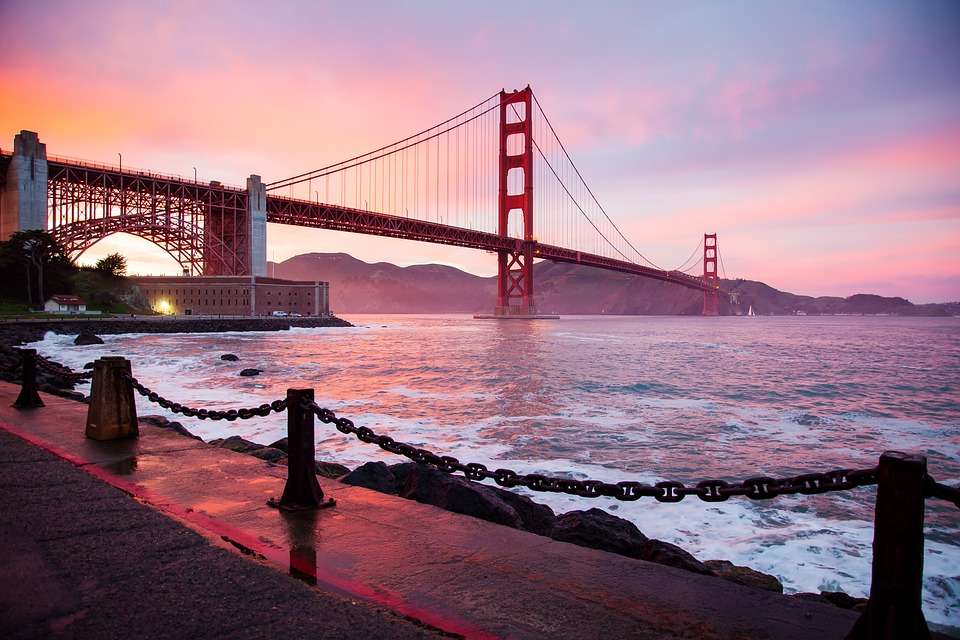San Francisco, an exciting and beautiful city, rises on a steep, hilly peninsula between the Pacific Ocean and San Francisco Bay, which is one of the finest natural harbors in the world and is the
San Francisco, an exciting and beautiful city, rises on a steep, hilly peninsula between the Pacific Ocean and San Francisco Bay, which is one of the finest natural harbors in the world and is the largest port on the West Coast. The port has 18 miles of shoreline, used to harbor ships. There are 42 piers that handle over 50,000,000 tons of waterborne cargo each year.
San Francisco is the second-largest city in California. Its metropolitan area is one of the largest in the country. The city is important both in banking and insurance and is the rail, truck and the air transportation center of the West and gateway to the Orient. The city is also the western headquarters of the communications industry as well as of a variety of manufacturing and processing businesses.
So, now let’s dive into the history of such a rich and fine city.
The History of San Francisco

European voyagers explored San Francisco Bay in the 17th century. The first settlement was founded by Spaniards in 1776. At that time, a site was chosen for a mission dedicated to Saint Francis of Assisi. The village that grew up around the Franciscan mission was called Yerba Buena. Until 1846, when the Stars and Stripes were first raised over Yerba Buena, it was under Spanish and then Mexican rule. The next year the village took the name, San Francisco.
What’s more exciting in the story is how in 1848, gold was discovered at Sutter’s Mill in Coloma on the American River, about 100 miles northeast in the Sierra Nevada mountains. Ships were abandoned in the harbor while their passengers and crews left for the gold country. Gold-seekers poured into San Francisco and turned the village into a rough-and-tumble boomtown.
In this lusty city, many people realized that there was more profit in supplying the needs of the gold miners than there was in mining. Thriving stores and supply houses sprang up. Other San Franciscans went into the import-export business with countries of the Far East. There are now more than 1,500 such firms in the city. Fortunes were made by the merchants in San Francisco, but few were made in the gold country.
Now, What About the Climate?

If you decide to visit San Francisco, let me tell you that the climate there is mild. Even during September, the warmest month, the temperature hardly ever goes above 70 degrees Fahrenheit. In winter, the temperature rarely goes below 32 degrees. The city’s fogs are well-known, but the sun shines for 66 % of the daylight hours.
What About the Places of Interest?

From the Twin Peaks, over 900 feet high in the center of the city, one looks straight down Market Street to the bay. Another magnificent view is from Coit Memorial Tower on Telegraph Hill. From there, it is possible to see the entrance to the bay, the cities on its eastern side and the great span of the Golden Gate Bridge.
Cable cars were introduced in 1872 to solve the huge problem of transportation in a city of hills. Today, they still run up and over Nob Hill and down the other side at 9 miles per hour, pulled by an endless steel cable under the street.
San Francisco’s famous Chinatown (known as the largest in the United States) is along Grant Avenue and nearby streets. It is a really colorful district of Chinese shops, restaurants and temples.
North of town, just east of the Golden Gate, is Fisherman’s Wharf, where fishing vessels bring their catch to sell. Fresh seafood dishes are a specialty at restaurants along the Wharf. The old sailing ship Balclutha is anchored near the Wharf and serves as a museum.
Finally, we come to Golden Gate Park, west of Twin Peaks, which is one of the most beautiful parks in the world. It contains the M.H de Young Memorial Museum, specializing in art, the California Academy of Sciences, with a planetarium, an aquarium and scientific exhibits and Spreckels Lake, where model-boat builders sail their ships.
So, who’s excited for San Francisco?

